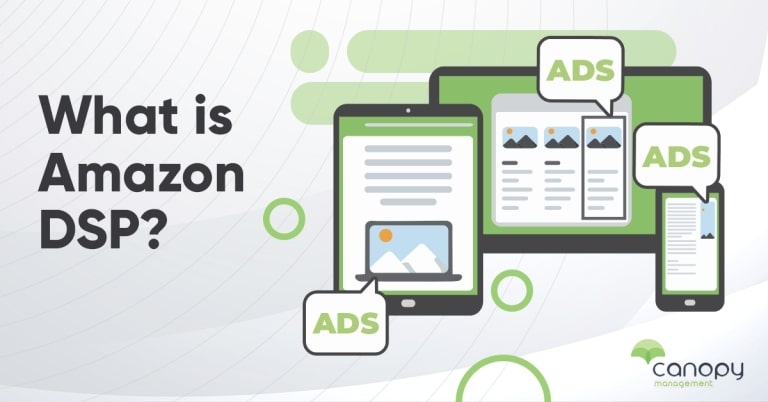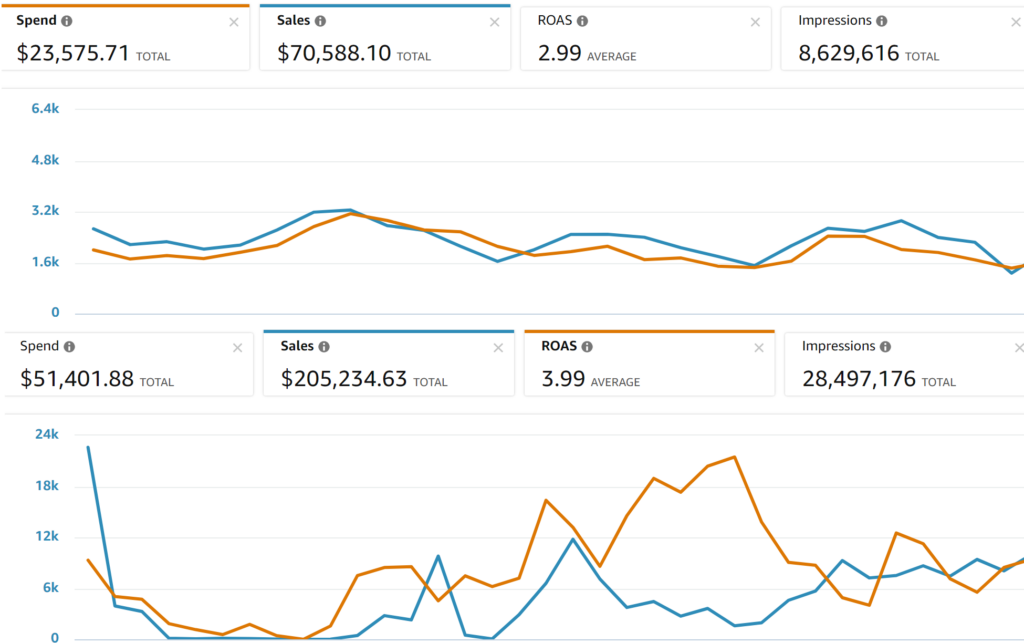Forget Data Doomsday, Use Amazon DSP to Reach New Audiences in 2024
Cookies are going the way of the dinosaurs. Amazon DSP might be the best way for advertisers to connect the dots between buyer intent and purchase!

The impending loss of third-party cookies in web browsers has many online sellers nervous. Cookies – small pieces of data that a website stores on a user’s computer or mobile device when they visit – allow marketers to track site visitors and target ads, personalizing the browsing experience.
Without cookies, online sellers and businesses worry that analytics and attribution will suffer, making it harder to understand the customer journey and purchase funnel. On the advertising side, retargeting ads and customized product recommendations will be more difficult without the user data cookies provide.
By the end of 2024, sellers will need to find alternative user tracking and targeting mechanisms if they want to continue effective digital customer acquisition and retention. Though workarounds like data clean rooms and zero party data exist, privacy changes mean that brands that need new data and strategies to personalize experiences are going to have to come up with a plan B.

Data Clean Rooms and Zero-Party Data?
It might sound a little far-fetched, but Google and every other big player on the internet are directing enormous amounts of money towards exotic alternatives to the time-tested cookie.
Data clean rooms and zero party data are two of the most talked about options.
As companies navigate increasing privacy regulations, and access to third-party cookie tracking is reduced, data clean rooms are intended to allow marketers to continue targeted advertising using a version of first-party data.
Thinking About Hiring an Amazon Management Agency?
Canopy’s Partners Achieve an Average 84% Profit Increase!
Let’s talkThe concept is much like a sterile hospital room – a secure, controlled environment for handling sensitive information. Partners securely pool data for audience insights and measurement, with consumers’ interests protected.
Within data clean rooms, advertisers can safely access consumer data from partners to power advertising and analytics. Data is combined and analyzed without ever being traced back to individuals.
Zero-party data is information that customers voluntarily provide to a business about themselves. Unlike data inferred from behavior tracking, zero-party data comes directly from the customer.
They offer it proactively, often with the expectation of a better, more personalized shopping experience in return.
Businesses can collect zero-party data through questions like:
- “How often do you want to hear from us?”
- “What kind of content is helpful to you?”
- “How would you describe your last purchase experience?”

Why Did Apple Come Out Against Cookies?
The 2021, IOS 14 update from Apple sent ripples throughout the eCommerce marketing and media buying community.
Apple enacted strict App Tracking Transparency guidelines that require iOS apps to explicitly ask users’ permission before collecting data or tracking their activity across apps and websites for third-party advertising and measurement purposes.
They did that for these four main reasons:
- Privacy – Protecting users’ privacy was a major motivation. Apple wanted to give its customers more transparency into what data apps collect and prevent unauthorized use of user data for advertising by third parties like Facebook.
- Security – Restricting app access to user data also bolsters iOS security by reducing potential vulnerabilities from uncontrolled data sharing. This aligns with Apple’s broader focus on security and encryption.
- Competitive advantage – Some allege App Tracking Transparency also provides an anti-competitive edge for Apple’s own advertising services, which aren’t subject to the same restrictions. It allows Apple to limit its rivals’ targeting capabilities within iOS.
- Corporate branding – The privacy-centric branding aligns with and enhances Apple’s desired image as a company focused on user experience and “thinking differently” compared to data collection-heavy companies like Google and Facebook.

What You Need to Know About Google’s 2024 Chrome Updates
Third-party cookies have been used on websites for decades to track user behavior across multiple sites. Much like Apple, privacy concerns have led Google’s Chrome and other browsers to eliminate them. (Firefox and Safari have already phased out third-party tracking)
By default, Chrome will soon completely restrict site access to third-party cookies. This means websites will have limited ability to track you across sites or serve personalized ads. It’s part of their “Privacy Sandbox” initiative for a web without third-party cookie tracking.
Starting January 4th 2024, Chrome began testing this tracking protection on 1% of global users. If selected, you’ll get a notification when you open Chrome. As you browse, third-party cookies will be restricted automatically in the background.
This test rollout aims to assess website readiness for a post third-party cookie world. Developers still have time to support alternative user tracking and targeting methods before Chrome fully phases out third-party cookies in mid-2024.
If a site doesn’t work well without third-party cookie access, Chrome may temporarily re-enable them for that domain. You’ll get a prompt allowing you to switch them back on for that website.
Amazon DSP Offers An Alternative First-Party Data Hack
First-party data is information collected by the web property or app itself. For example, when you collect subscriber and buyer information in your Shopify store, that’s first-party data. Similarly when information is collected from Amazon shoppers, first-party data is the result.
All of the restrictions coming from Apple, Google, and other platforms are around the sharing of data to third parties. But when you gain data from a voluntary opt in through a property you control, you aren’t sharing anything with a third party.
This means that all tracking throughout properties you own or within your properties owned by the ad platform (as in the case with Facebook) will still work.
How does this benefit an Amazon seller? That’s where Amazon Demand-Side Platform advertising comes in.

What is Amazon DSP?
A Demand-Side Platform (DSP) ad offers one of the most impactful opportunities for advertisers to scale in the post-third-party-data world.
Amazon DSP is an advertising technology platform that allows advertisers to programmatically purchase display, video, and audio ads both on and off Amazon.
Some key things to know about Amazon DSP:
- It provides advertisers tools to manage ad campaigns and budgets, target audiences, and optimize ads in real-time across various channels.
- It leverages Amazon’s data and online reach to help match ads to audiences to increase relevance.
- It enables advertisers to access Amazon’s proprietary video and streaming inventory, as well as other partner networks like video publishers and audio platforms.
- It streamlines buying across programmatic ad auctions, and the open market.
Importantly, Amazon lends targeting options to DSP advertisers as well.
Amazon DSP Ads Give Advertisers the Power of First-Party Data
Here’s a quick list of targeting options offered by Amazon DSP:
- In-Market – These are actual browsers and shoppers of specific products or categories ON Amazon.com.
- Lifestyle – These are people who’s shopping patterns have been identified to fit a specific pattern that can categorize them as tending to make certain lifestyle choices.
- Demographic – Gender, age, income level, etc.
- Retargeting – Remarketing people who viewed your detail pages but didn’t convert.
- Advertiser Audiences – Not only can you upload a custom audience of your own (email list or customers from your website), but you can also add a pixel to your site to create this audience.
- Other Custom Audiences – You also have the ability to target interests based on things like Prime Video views.

Amazon DSP = Highly Efficient Targeting Opportunities
Extend your reach
Your ideal demographic is probably spending the day on multiple platforms and devices. By leveraging first-party data across your Amazon DSP platforms, you’ll be able to benefit from exponential increases in knowledge and reach.
Increase the efficiency of your ad campaign
Maybe you’re reaching back out to shoppers that didn’t buy, or you’re making initial contact with a fresh audience who have searched for products just like yours. In either case, you’re establishing contact with shoppers who have already shown interest.
Beginning your advertising with that kind of a head start is the recipe for success.
These are the reasons why current advertisers are increasing their DSP ad budget every quarter. However, compared to Sponsored Product and Sponsored Brand ads, DSP ads are still underutilized.
That creates an opportunity for clever Amazon sellers to take advantage of this undervalued ad real estate.
Ultimately, Amazon offers tremendous value for ad-buyers and marketers, and DSP ads are the hottest thing on the block right now.
If you aren’t taking advantage of it, you are leaving money on the table. Period.

Amazon Has a Lot to Offer to Media Buyers
Due to their rapid growth and massive revenue, Amazon will continue to invest heavily into offering more robust advertising options for its customers and sellers. They’ve already shown this by expanding into video ads and artificial intelligence algorithms that work to only show the most relevant ads to ready buyers.
It’s important to remember that 48% of Amazon sponsored display ads impact non-Amazon sales. Overall, it appears that Amazon has a lot to offer media buyers, not just Amazon audiences. In fact, in an ad-buyer survey conducted by Cowen of 52 senior U.S. ad-buyers, it was revealed that Amazon ads have the second highest ROI next to Google search!!
Amazon has immeasurable amounts of shopper data that allow audiences to be targeted based on known behaviors. This gives them quite an advantage. Further, Amazon owns many popular websites on which they can track an advertiser audience, gather more data, and serve up ad campaigns as well.
Amazon gains the shopper, owns their data AND the sites they visit outside of the marketplace, creating brand awareness and other critical components of a profitable advertising campaign.
Potential customers can’t help being influenced by the power of the Amazon platform.
How Canopy Management Can Help
Canopy Management is a full-service marketing agency for Amazon and Walmart sellers. Our team consists of former Amazonians, multi-million dollar sellers, and award-winning experts.
When you consider the many ways that Canopy Management can help you grow your business, you’ll see why selling on Amazon is much easier “under the Canopy.”
- Strategic Growth Planning
- Listing Copywriting Optimization
- Listing Photography
- Product Videography
- Advertising Management
- Customer Service
- Demand Side Platform (Amazon DSP)
- Amazon Posts
- Full Service Management
- Amazon Review Aggregation



